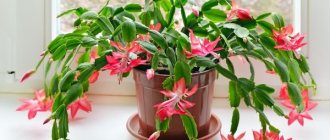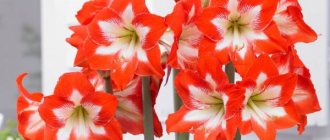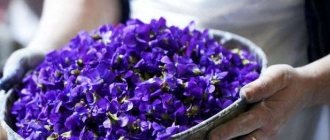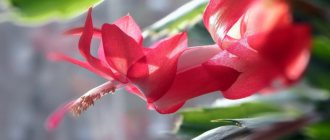You've decided to add exotics to your flower garden, haven't you? Indeed, canna is that same tropical plant that will definitely decorate your site, not only the garden, but also the terrace, greenhouse, balcony or bright windowsill, because it can be grown not only in open ground, but also in pots.
Next, you will learn when to plant and how to grow cannas in open ground and at home in a pot.
Contents in the apartment
Not all gardeners have a spacious cellar to store their favorite cannas. In this case, storing tubers in winter can be done directly in the apartment. To do this, use one of the following methods:
- Storage in pots.
- Cold storage.
- Storing as a houseplant.
If the first option is considered, then it has several differences from storage in the cellar. As soon as the first night frosts begin, the flower must be cleared of dead leaves and dried flower stalks, and then placed in a pot with soil. This method is suitable for keeping culture in the attic, closed loggia and even in an apartment. In the latter case, you need to find a cool space, preferably near a balcony door, away from the heating radiators. Watering the plant is carried out once every 1-1.5 months.
Advice!
Closer to spring, the intensity of such procedures can be increased so that the flower has time to “wake up” from winter sleep. And half a month before moving the flowers into open soil, they need to be fed with a special fertilizer.
When storing cannas in the refrigerator, you can follow a simple preparation principle. To do this, you need to trim the flowers and stems by 5-10 centimeters, and then treat the cut areas with iodine. After digging up the root system and rinsing it with running water, they need to be immersed for a day in a solution of potassium permanganate or a special disinfectant composition, which can be bought at a flower shop.
After 24 hours, the flowers can be removed from the container with the solution and then dried. After this, they need to be wrapped in damp newspaper and closed in a plastic container, which should eventually end up in the refrigerator. You need to make several ventilation holes in the containers.
Once a month, it is necessary to open the container and check the canna root system for rot or drying. This method is suitable for owners of several refrigerators or a small number of flowers, since storing them requires a lot of space. At the beginning of April, the tubers are taken out of the chambers and prepared for the upcoming planting.
You may be interested in:
Late flowers: names of autumn plants for flower beds Autumn is the time when everyone around is preparing for the cold: people are harvesting crops, making preparations for the winter, taking out warm clothes and...Read more...
Diseases and pests
Cannas usually do not suffer from serious diseases. Although they can be affected by some diseases:
- viral diseases are signs of damage: plants do not bloom, do not have bright spots on the leaves, various types of deformations are observed;
- fungal (for example, rust);
- bacterial (canna bacteriosis).
The development of viral diseases is facilitated by unfavorable stressful growing and care conditions:
- strong sunlight,
- quick location change,
- high humidity,
- soil is too wet.
The plant can be affected by pests:
- aphids,
- snails and slugs,
- wireworms,
- nematodes.
Slugs are easy to catch in the evening, using beer traps; you can read more in the article on how to get rid of slugs. The presence of pests can be indicated by traces of dried mucus and round eggs in cracks in the ground and secluded places.
Aphids are destroyed with chemicals; a drug called Confidor 200 SL in a 0.04% concentration is suitable, that is: 4 ml per 10 liters of water.
Reasons for popularity or why cannes are so in demand
cannas can be planted individually or added to a flower arrangement
When choosing which flowers will be the best and undemanding decoration for a flower garden, be sure to take a closer look at the cannas. It’s not for nothing that they are the favorites of designers when decorating city flower beds; they are planted as a separate plant or as part of compositions. There are several reasons for these magnificent flowers to appear on your site:
- Plants are undemanding and do not require special care. They practically don't get sick. They are not afraid of pests. They can easily tolerate short-term drops in temperature. They are drought-resistant plants.
- The flower amazes with the beauty of the inflorescence. Its beautiful large shape will definitely become the center of attention of the flower bed and flower garden.
- Canna has a long flowering period: about two months it will delight with large flowers beautifully collected in inflorescences.
- A flower decorates a flowerbed not only due to its inflorescences. Currently, there are plants with beautiful decorative leaf shapes that look great in the garden.
- The plant itself is distinguished by a thick, fleshy stem up to 2 m high. The straight shape fits beautifully into the floral ensemble. And the strong stem can withstand wind loads.
Kanna: appearance
unusual two-color canna flower
As noted, canna is a large plant with a thick, straight stem that does not need to be supported. An adult healthy flower is capable of throwing three to four arrows. The height can be from half a meter to two. These sizes allow the flower to be grown both in the ground and in flower pots. There is no significant difference in care. Here are some features of canna:
- Cannas are perennial plants. Their heat-loving nature is incompatible with the cold Russian winter. Therefore, when overwintering in open spaces, the plant most often dies.
- A feature, and some consider this property a disadvantage, is the lack of odor.
- The flower blooms four months after the start of shoot development. Flowering begins in July and lasts about two months, or even until the first frost.
- Canna is a large flower from 3 to 15 cm in size, reaching 30 cm in inflorescences, painted in any shades of yellow, red, burgundy and orange. 10 mm is considered standard. Most often colored red, yellow shades are less common. The snow-white color is unique. It can be either plain or dotted or striped.
- The canna stem has large, oblong, elongated leaves that are significant in size. Can be up to 80 cm.
delicate Salmon Pink canna flower
Cannas are heat-loving plants, so they do not like early planting in open ground. But it is also worth considering the fact that the sooner a flower begins to develop, the faster it will bloom and begin to decorate the flowerbed. Therefore, for planting, a technique is used in which the flower is germinated in advance and thereby artificially helps to begin flowering earlier.
Canna: most common varieties
there are more than 50 varieties of cannas
Cannes are very popular flowers that are loved by collectors. Currently, the trading network offers a large number of beautiful varieties, differing in the size and color of the flower, stem height, and decorative features of the leaves. Even the most demanding lover can find a variety that will satisfy his most sophisticated needs.
The following varieties are most widespread:
- Indian eland is one of the most common and unpretentious. Easily grown in garden beds. It does not require special care. It belongs to the dwarf varieties, its average height is just over half a meter. Perfect for forming borders. Planted in containers located around the site, it will decorate any suburban space with its excellent appearance. The leaves initially have shades of soft green, which gradually darken during the summer. The plant compensates for its low growth with its stunning colors and appearance of inflorescences.
Varieties
In nature, today, there are fifty species of eland. In gardening and indoor floriculture, no more than 8 are grown. The most famous varieties of cannas.
- Indian.
The flower grows up to one and a half meters. The stem is rich green in color and covered with elongated leaves. Pink flowers are collected in a raceme inflorescence at the tip of the stem. Blooms continuously from early summer until cold weather.
- Cochineal.
Large plant, up to 200 cm in height. The flowers are a bright red-orange hue, more than 5 cm long. Blooms all summer.
- Garden (hybrid).
A group of hybrid plants obtained from crossing different species of cannas. Some varieties do not produce seeds. Varieties:
- Lucifer (scarlet flowers with a yellow border), bush height 50 - 60 cm;
- Picasso (yellow petals with red “freckles”), height about a meter;
- America (pure red color), plant height 130 - 150 cm;
- Sunny beauty (yellow flowers), canna height 100 cm.
How does Canna survive winter outdoors?
In Russian conditions, eland can winter only in the southernmost regions of the country. In the rest of the territory, the flower is dug up for the winter and stored in a dry basement.
Preparation for winter begins in September, when the base of the canna stem is covered with soil to a depth of 15 - 20 cm. This measure will protect the roots from rotting.
The plant is dug up after the first serious frost, which will kill the above-ground part. The stem and foliage of the canna are cut off, and the root is dug up and placed in a pot or bucket.
Canna storage temperature is + 5 + 10 degrees. During the winter, the earthen ball is periodically sprinkled with water. The humidity of the soil in which the tubers are located should be about 50%.
Correct fit
As a resident of warm and humid places, the sunniest area in the garden is chosen for canna.
The flower must be reliably sheltered from gusts of wind, otherwise the tall peduncles may break. For especially tall varieties, it will be necessary to install durable stakes for peduncles.
Loose soil rich in humus with good moisture holding capacity is suitable for the plant. These can be fertile loams and even sandy loams, provided there is sufficient moisture. Before planting cannas, at least 5 kg of good fatty humus (not fresh manure!) and about 4 kg of coarse sand are added to the site. The soil is dug up to a depth of 35 cm, so the plant has a large branched rhizome.
Advice. The flower responds positively to the arrangement of a “warm bed” when fresh mullein is placed on the bottom of the planting holes. The manure is poured with hot water, covered with soil in a layer of 25 cm, and only then the canna rhizome is planted. Burning manure releases heat, which warms the roots of the flower.
The flower is planted in May, when the threat of frost has passed. The distance between bushes is maintained at 50 - 90 cm, depending on the size of the variety. The canna rhizome is immersed 10 cm into the soil.
Flower propagation methods
The plant can reproduce in several ways. The choice of propagation method depends on the personal preferences of the gardener.
Rhizome division
One of the simplest methods of culture propagation. To use it is necessary to prepare a root on which there will be shoots. The root is divided into several pieces. Each segment must have at least 2 buds. After the root is divided, the cut areas should be treated with manganese or wood ash.
Parts of the rhizome are placed in a warm place to awaken. Once every 2-3 days, the roots are sprayed with warm water. Parts of the root must be placed in a mixture of peat and sand for two weeks. This period is enough for additional root shoots to develop and the bud to sprout. The sprouted root parts are placed in open ground and covered with plastic film. To ensure that the flower does not have to be replanted, when planting in the ground, a distance of at least 60 cm is maintained between the holes.
Seeds
Propagation of cannas by seeds is very rarely used and can contribute to the appearance of new colors and forms of the plant. In order to plant a flower in open ground in spring, the seeds should be germinated. Seeds can be purchased at a special store or collected yourself. The seeds are collected after the plant has completely flowered and formed a seed pod. The seeds are large in size and have a hard shell. Without pre-soaking, they rarely sprout.
After the planting material is treated with boiling water and placed in the ground, it is necessary to regularly water the holes. Seeds are planted in pots and only after seedlings appear, they are planted in open ground.
Cannas are one of the unique flowers that can be used to decorate the garden. The plant requires compliance with certain rules of care, otherwise it is often affected by diseases and pests. Cannas can be grown not only in open ground, but also at home. The care process is no different, but the flower is large and takes up a lot of space, which often causes discomfort.
Growing a flower in the garden
A fast-growing large flower is used to decorate unsightly places in the garden (ugly hedges, compost heaps). Canna looks great in a mixborder in the background. It is also good in the front area, planted in a flowerbed or flowerpot.
We recommend reading: everything about the houseplant Beloperon - growing a flower at home.
How to grow decorative barberry at home: tips for planting and care, useful properties. See information here.
The whole truth about the indoor plant laurel - https://sazhaem.info/plants/foliage/blagorodnyj-lavr.html
Is it possible to keep the plant in the house?
Fuchsia in the house is a kind of talisman of well-being and success. It charges household members with positive energy, joy, love of life, drives out bad moods and irritation, thereby reducing the number of quarrels and conflicts.
The benefits of an indoor flower
The plant helps people find a common language, fills the atmosphere in the house with mutual understanding, support, and mutual respect.
Fuchsia is especially indispensable where a large family of several generations lives under one roof. The flower eliminates resentment and alienation, allowing everyone to feel needed and loved.
If the plant is in the house for a long time, its owners develop intuition, and in some cases, the gift of clairvoyance.
The owners of the flower recover strength more easily and quickly after heavy physical or psychological stress, and release accumulated negative energy. To do this, it is enough to be near the fuchsia even for a short time. In addition, the plant gives household members endurance and performance.
How can it be dangerous?
Sometimes there is an opinion that fuchsia is a widow's flower. It is also called widow's tears. Some particularly superstitious people believe that the plant drives men out of the house. However, there is no explanation on what this negative idea of the plant is based. Each gardener will have to decide for himself whether to have fuchsia at home or not. But most flower owners do not pay attention to this superstition, considering it false.
When to plant cannas (flowers)
Growing in open ground begins with preparing the soil. You can begin this process as soon as the night frosts stop. Take full responsibility when choosing a place for a plant. Further flowering depends on this. Canna should grow in a place where there are no drafts, fertile and warm soil, and sufficient sunlight. The soil composition should include:
- leaf soil;
- humus;
- peat;
- coarse sand.
All these components must be contained in equal parts. And don't forget to provide good drainage. But it is better not to start planting seedlings before the ninth of May. This is due to the fact that in spring the air temperature changes quite often. And from the heat of the day in the evening there may be nothing left. Such changes can have a very detrimental effect on the plant and slow down not only its growth, but also its flowering. Growing canna outdoors can be very difficult.
Storing canna in the apartment in winter
If it is not possible to place the plant in a cellar, basement or loggia for the winter, you can store it directly in the apartment. To do this, you need to dig up the whole flower at the end of September, before the onset of cold weather, without cutting it. The lump of earth must be left along with the roots. Next you need to transplant the canna into a flower pot.
The flowerpot should be large and spacious enough. This will allow the root system of the flower to develop normally. After replanting, the soil should be thoroughly watered with a solution of potassium permanganate, this will allow it to be disinfected. The plant needs to be moved indoors.
With this storage, the plant will continue to flower until mid-winter, then shed its foliage and go into a dormant state. Dormancy when storing a flower at home lasts no more than two months. Then the flower begins to grow, and with the onset of consistently warm weather it can return to the garden again.
Also, when stored indoors, canna requires more frequent watering, because the air is usually very dry in winter. Once a month you need to fertilize the plants with complex mineral fertilizer.
The necessary conditions
As soon as flower sprouts appear on the surface of the soil, it is useful to mulch the ground with straw, high peat, and mown grass. This measure will allow moisture to be better retained in the soil. And eland loves to “drink.”
The plant should be watered only with warm water, abundantly, but without allowing the soil to become waterlogged.
Stagnation of water at the roots of the canna, combined with cool weather, is especially dangerous. Fungal diseases will not keep you waiting. During the flowering period, the need for moisture increases. In autumn, watering is reduced, giving the rhizomes the opportunity to ripen.
Canna is not demanding on the subcortex; it is enough to water the plant with a fertilizer solution during the period of bud formation, and again during flowering. Phosphorus-potassium mineral fertilizers are used for flowering garden plants.
Why do cannes need to be dug up for the winter?
As with most tropical plants, sub-zero temperatures are detrimental to cannas. Therefore, in order to preserve these beautiful plants, they should be dug up every autumn before the onset of cold weather and planted again in the ground in the spring, as soon as warm weather sets in.
Cannes are recommended to be dug annually.
In the southern regions, where the soil temperature in winter remains between 0 and -5 degrees, plants can be left to overwinter in the ground. At the same time, they are covered for the winter, for which they should:
- trim flower stalks and leaves to the base;
- lay down spruce branches or add a layer of pine needles;
- Drive pegs along the edges of the protective area and lay mats on top of them;
- fix them securely.
If the soil temperature in winter drops below -6 degrees, the cannas must be dug up in the fall before frost sets in and stored until spring. The first night frosts in the fall can serve as a signal to start work, but especially valuable varieties can be dug up in mid-September, without relying on the vicissitudes of the weather.
For northern regions, it is recommended to dig up flowers from open flower beds in late August - early September. It is not advisable to miss deadlines in order to prevent the roots from freezing and rotting during storage.
Digging dates should not be missed to prevent the roots from freezing.
Description of the flower and its preferences
The genus Canna is the only one in the Cannaceae family. This is a herbaceous plant, perennial, growing in the tropical and temperate climates of India, China, South America, and Mexico.
Canna is a tall plant, reaching 2 m under favorable conditions. The powerful hollow stem is covered with sessile, smooth, ovoid leaves, up to half a meter in size. Their color varies from emerald to purple.
The flower is similar in shape to an iris, its color can be scarlet, yellow, pink, white, or have a light border or spots. Canna flowering begins in June and lasts all summer, until the arrival of cold weather.
Important! Canna is easily damaged by frost. It, like the dahlia, must be dug up in the fall and stored until spring in a dry and cool place.
Types and varieties of cannes with names and photos
The progenitor of almost all types of cannas. The cultivated varieties of Indian canna obtained as a result of selection are called garden canna. These hybrids are divided into three groups.
Cannes Crozy (French canna)
They are considered a low-growing species (60-160 cm), their flowers are similar to gladioli. The dark green or purple-pink leaves are covered in white.
- Livadia: up to a meter in height, red-crimson flowers appear on a peduncle 25-30 cm long, the petals have a bend, begins to bloom in July;
- America: 120-140 cm high, blood-red flowers 12 cm in diameter, inflorescence length 30-35 cm, purple leaves, blooms in July;
- President: up to 1 meter high, bright red flowering on a peduncle 30 cm high, standard leaf color - green, begins to bloom in July.
Orchid cannas
A tall species with a height of 1-2 m. The flowers are large - 12.5-17.5 cm with thin corrugated edges, shaped like cattleyas. The leaves are green and may have a purple tint.
- Andenken an Wilhelm Pfitzer: 110-140 cm high, the inflorescence reaches a length of 30 cm, the color of the flowers is bright orange with red strokes, the leaves are brown-purple, begins to bloom in July;
- Suevia: up to a meter tall, lemon-colored flowers measuring 12 by 15 cm appear in mid-July, green leaves;
- Richard Wallace: height about a meter, flowers are light yellow with red speckles, inflorescence length is 20-25 cm, blooms in July.
Deciduous (small-flowered) cannas
They grow up to 3 m in height, the leaves are very beautiful, colored green, purple, violet-green, the flowers are small - no more than 6 cm in size, this species is rarely grown in culture.
Durban is the most famous variety of small-flowered canna. The flowers are yellow-orange, the color of the leaves is more interesting - pink-yellow-bronze-green stripes.
Preparing cannas for winter is simple and any novice gardener can do it. Basically, you just need to choose the right moment, prune the plants, dig them up and store them. Not confident in your knowledge? Then we'll look at everything step by step.
By the way, you only need to dig up cannas for the winter in those regions where the winter temperature drops below -5°C. If you are lucky enough to live in an area with warm winters, it is enough to cut off the ground part of the cannas and cover the bushes with spruce branches, straw or other mulch.
Is it possible to keep a canna flower at home, how to grow and care for it
Is it possible to keep a canna flower at home and how to grow the plant correctly. Despite its exotic nature, the plant takes root well at home. With proper care, canna will delight you with its bright blooms for a very long time. Although the plant is unpretentious in care, when propagating it you will have to work a little to grow the flower healthy.
Is it possible to grow canna flower at home?
Cannas can often be found growing in summer cottages. Due to the size of the bush, it can be problematic to keep in the house. The plant requires a lot of space to grow properly. If the apartment allows, then in the fall a flower from the plot can be transplanted into a pot and placed at home. Being constantly warm, the canna will bloom all year round with a break of two months.
To grow the crop at home, only large pots with a diameter of more than 50 cm are used. It’s good if you have an insulated loggia at home, then the flower will have enough space and light. But if not, you can put it on the floor. The main thing is that the plant gets sunlight.
Which varieties are suitable for home cultivation?
There are special varieties for growing indoors that do not grow as large as outdoor varieties.
Homemade canna varieties:
- Livadia is a bush up to 1 m high. The inflorescences are scarlet, large. Up to 25 cm in diameter. The foliage is large. Flowering begins in July.
- America - the height of the stem is 1.2-1.4 m. The petals are red in color, 10-14 cm in diameter. The flowering period occurs in the second decade of July.
- President is a bush up to 1 m high, scarlet inflorescences, 14-17 cm in diameter. The foliage is rich green in color. The flowering period begins in July.
- Richard Wallace - a bush up to 1.2 m high. The petals are yellow with red-brown dashes. Flowering begins in early July.
- Suevia is a plant up to 1 m high. The inflorescences are of a rich yellow hue. The flowering period occurs in the second half of July.
- Andenken an Pfitzer - stem height is 1-1.4 m. The inflorescences are orange-yellow with red dashes. The length of the inflorescence is 30 cm. The foliage is rich green.
- Cleopatra is a low-growing variety up to 1 m high. The petals of the inflorescence are yellow with scarlet stripes.
- Orange Magic - the height of the stem is about 80 cm. The shade of the petals is peach. The inflorescences are small, 7 cm in diameter.
Even homemade canna varieties are never less than 1 m. On average, the height of varieties for growing at home ranges from 1-1.4 m.
Methods for germinating canna
There are two ways to grow canna - seed and from rhizomes. Both methods are quite effective. Only when growing with seeds you will have to be patient; this method is not quick.
How to grow canna from seeds
The main disadvantage of this method of canna breeding is that young plants do not retain the varietal characteristics of their parent flowers. Also, seeds may not appear on all varieties, but on some in small quantities and very late after flowering.
For planting, you need to use only those seeds that are fully ripe. If plants are grown outside, they bloom until autumn. You need to seize the moment and collect planting material when it is already ripe, but do this before the onset of frost.
Before sowing seeds, they need to be prepared. The seed shell is thick, because of this the emergence of seedlings may be delayed or may not occur at all. Before planting, you can rub it with sandpaper.
You can plant seeds in late February - early March.
- Drainage is poured into the bottom of the container, and then soil is placed.
- Make small holes in the soil and plant the seeds.
- Lightly sprinkle with soil.
At the end of planting, water generously with warm water. Planting material can be planted either in individual peat pots or in a common container. After the seeds hatch and grow a little, they need to be picked. If the seeds were planted in different containers at once, this step can be skipped.
For picking, it is better to use peat cups and, together with them, plant the bush in a pot in a permanent place. The seedlings are carefully removed. The main thing is not to damage the root system, which has just begun to form. The seedlings need to be planted together with the lump of soil in which they grew before.
How to germinate from rhizomes
The easiest way to grow cannas is from rhizomes. When propagated by this method, unlike seed propagation, varietal characteristics are preserved. Spring is best for growing this way.
The process of growing a flower from a rhizome:
- Dig up the bush and carefully divide the rhizome.
- For cuts, use a sharp knife, which is pre-disinfected.
- The cut areas are treated with antifungal agents: dusted with wood ash or treated with a solution of potassium permanganate.
- For planting, use soil containing peat, turf and sand in equal quantities.
- You can also use wet sawdust instead of soil.
- It is necessary to plant so that the rhizome is not too deep.
- At the end of planting, lightly sprinkle the rhizome with soil or sawdust.
Water the soil with warm water. It is also good if you add a little potassium permanganate to the water.
Basic landing rules
When growing cannas, it is necessary to pay as much attention to the plants as possible during planting to ensure they grow healthy and strong.
Required soil and drainage
Drainage must be laid at the bottom of the planting hole. Drainage is needed so that excess moisture comes out through the holes at the bottom of the pot. It also promotes air circulation in the soil. Then the soil is filled in. Any soil will do for flowering plants. You can prepare the soil mixture yourself. To do this, mix peat, sand and turf in equal parts.
Pot volume
Canna is a tall plant, so the flower pot requires a spacious one. It should be at least 50 cm in diameter. It is good if the height of the pot is about 1 m. The root system needs a lot of space to develop normally.
Timing and technology of sowing and planting root shoots
Canna is transplanted into separate pots after a shoot grows from the rhizome and several full leaves appear on it. The timing depends on when the root shoot was planted. Basically, seedlings are transplanted to a permanent location closer to April. During this period, the daylight hours increase, and it is easier for the seedlings to get used to the new place.
- Pour drainage (expanded clay, small crushed stone, pebbles) into the bottom of the pot.
- Pour out the soil mixture.
- Make a hole in the soil and plant a seedling.
- It is not advisable to deepen it too much.
- Cover with soil and compact it near the base of the stem.
Water with warm filtered water and place the pot in a sunny place.
How to care for your home canoe
Indoor canna needs care in the same way as outdoor ones. And maybe even more. At home, the plant does not receive as much sunlight, and the bush is often cramped in a pot. Therefore, it is important not to forget about caring for the bush.
Why artificial flowers cannot be kept in the house: folk signs and beliefs of different nations
It is believed that any inanimate flower arrangement is an energy vampire. She will take away positive energy from the house, but will not give anything in return: she does not breathe, does not grow, does not release oxygen. Artificial flowers are especially harmful to a home filled with warmth and love. Such decorations, according to folk signs and beliefs, should not be in residential premises.
If you believe the signs, then artificial flowers have no place in the house
Reasons for this:
- Such flowers evoke an association with funerals and cemeteries. Lifeless bouquets are brought to the dead and they decorate graves. And in a house where people live, it’s even scary to store them.
- Their presence in the house leads to marital disagreements, quarrels, separation (if you place them in the bedroom).
- They cause diseases (artificial climbing plants, ivy, synthetic reeds) and foretell death (wax flowers).
- People who have flowers made from artificial materials in their home interior are doomed to a lonely life.
All these signs and superstitions are mainly widespread among representatives of the Slavic peoples in Russia, Ukraine, and Belarus. It is there that there is a tradition of coming to funerals with artificial flowers.
But in China and Korea, for example, they do not give fresh flowers for weddings and other celebrations. They are believed to symbolize death and funerals, since they quickly wither and die. They use artificial flower bouquets for festive occasions, believing that they are eternal. Dead flowers were used instead of living ones back in Ancient Greece, and in the Middle Ages, currently - in Italy and Spain.
What do artificial flowers mean in the light of teachings?
Eastern sages considered the artificial flower a symbol of loneliness. And the Chinese teaching of Feng Shui about the proper arrangement of the home has a favorable attitude towards artificial flowers
In it, attention is focused on the color of the flower and there is no division of flowers into artificial or natural. According to teachings, beautiful (even not real) flowers can charge a home with positive energy and create coziness in the room
Feng Shui says that beautiful artificial flowers charge the house with positive energy
It is believed that they, regardless of the material they are made of, are imbued with the energy of their creator. After all, he puts his strength, talent and soul into these works. Artificial flowers play the role of a talisman of good luck, a talisman against various misfortunes.
Interesting varieties
There are numerous varieties of cannas, differing in size, color of flowers, leaves - large-flowered and less spectacular, small-flowered.
Grouping varieties by color of flowers and leaves
| Color of flowers, leaves | Varieties | Photo |
| With red flowers |
| President |
| With pink flowers |
| Pink Harmony |
| With red-crimson flowers | Crozi Livadia | Livadia |
| With yellow flowers |
| Eureka |
| With orange flowers |
| Orange Beauty |
| With white flowers |
| Ermine |
| Combined, multi-color |
| Canna Cleopatra (photo) |
| with brown-yellow leaves | Durban | Durban |
| green leaves with light stripes | Yellow Bangkok | Yellow Bangkok |
Do you know how to store cannas in winter?
Cannas are incredibly beautiful large perennial flowers, stunning in their variety of colors. They are not demanding in terms of growing conditions and are not fussy to care for, however, they are not so often found in the garden. Cannas bloom from mid-July until the first frost, flower height is from 30 cm to 1.5 meters.
The flower is of tropical origin, so frost is destructive for it. Canna reproduces by dividing the rhizome in early spring, in March or April. The price of a flower is quite high, so the question is how to preserve planting material until spring. There are several methods that have been tested by experienced flower growers.
Storing cannas in the cellar
After the first frost, and this is somewhere between September and October, the cannes are dug up. In this case, first the stem is cut, leaving a height of 15 to 20 cm, then the flower is dug up and dried a little under a canopy.
When digging, there is no need to completely remove the soil from the root system; it is better if the cannas are stored with a lump of earth.
The rhizome is transferred to wooden boxes and sprinkled well with humus, soil with sawdust, peat and sand. It is desirable that the soil humidity is at least 50 - 60%, and the air temperature in the cellar is 6 - 8 degrees Celsius.
At least once a month, visit your beauty and inspect the plant and provide the necessary watering so that the rhizome does not dry out. If, on the contrary, rotten areas appear, then they are cut off to good tissue. Sprinkle the cut areas with charcoal or treat with iodine. A sudden change in temperature in the cellar should not be allowed, as this can cause the rhizomes to freeze or, conversely, rot.
Dormant period in a pot
There is a second way to store cannas in winter. Before digging up the plant, trim only dry leaves and flower stalks at the very root. Plant the trimmed plant with a ball of earth in a pot. The storage temperature should be no higher than 12 - 15 degrees. This could be a cool veranda or attic, loggia. Water the flower periodically, about once or twice a month.
Kanna can also be in a lighted room near the balcony door. Under such storage conditions, the buds will ripen very well, which will subsequently produce good strong flower stalks. When spring comes, it is necessary to gradually increase the amount of watering so that the plant wakes up. Two weeks before planting in the ground, the plant is fed.
Storage with flowering
You can put it in a pot and water it normally. Then they will delight the eye with flowering until December, and sometimes until January.
Yes, they can be grown in large pots at home! Moreover, in indoor conditions they bloom almost all year round, with only a short dormant period of 1.5 - 2.5 months.
During the dormant period, the stem and leaves dry out and fall off, and new leaves begin to form in their place. When storing or growing in this way, the main thing is that the flower has enough space in the pot.
You should not forget about a sufficient amount of nutrients. To do this, you need to feed the canna once a month with mineral fertilizers or water it with nutrient mixtures for any indoor flowers.
You should not use various mash with humus, since an abundance of fertilizers can lead to the withering of the plant. Flowering canna can be transplanted into open ground. However, you should not rush, as the slightest frost can destroy the plant.
Refrigerator storage
Some gardeners store low-grade canna in the refrigerator. If space allows you, then this option should not be excluded either.
The principle of preparing rhizomes is simple: we dig them up and wash them under running water, then soak them in a disinfectant solution for a day and, after drying, store them for storage, wrapping them in newsprint. For a disinfectant solution, you can use regular potassium permanganate or various solutions from the store.
Cannas should be placed loosely in the vegetable storage compartment. The rhizome should also be checked occasionally to ensure there is no rot. This method is suitable for those who have few rhizomes, because after all, the refrigerator is not rubber.
Closer to mid-spring, the root system should be divided according to the number of shoots and planted in pots for growth. For planting, take an earthen mixture: peat, sand and black soil in equal parts. When strong shoots appear, the plant should be fed. To do this, you should take mineral fertilizers, 40-50 g. per 1 m2.
And after the frosts leave, this is the beginning of June, they are taken to open ground. The place should be sunny or partial shade, the soil should be well fertilized. Before planting the plant, water the hole generously; when the water is absorbed, you can plant the flower. Cannes will begin to delight with large and rich flowers in mid-July or early August.
This depends on the type of plant.
general characteristics
Before you start growing canna flower, you need to know its basic characteristics. This plant has an original appearance: its leaves resemble a banana, and its inflorescences can be easily confused with an orchid or gladiolus. It has practically no disadvantages, however, when grown in our latitudes, the flower has absolutely no aroma, and it also does not tolerate our winter in open ground. But the advantages will have to be listed for quite a long time.
First of all, this is, of course, the beautiful appearance of the plant. Not only bright inflorescences stand out, but also wide green leaves. Canna will decorate any garden, and its flowering will delight you from early June until the onset of the first frost. Many gardeners are accustomed to the fact that such beautiful plants are very whimsical, but such a stereotype is completely inapplicable to canna. She is not at all afraid of drought and does not require any special care.
The plant has a fibrous root system that grows very rapidly. The flowering stem can reach three meters in height. Beautiful and large leaves have an elliptical shape, slightly pointed at the end. They can reach eighty centimeters in length and thirty in width. They are especially valued in flower shops and are used to create beautiful flower arrangements. The flowers are asymmetrical and initially were only red in color, but breeders did not sit still, and now you can admire inflorescences with a variety of shades and sometimes not even monochromatic. And after flowering ends, you can find a three-lobed capsule on the stem, which is both a fruit and a seed.
Where is the best place to place the plant?
It is better to grow a flower in the office - this is the most harmonious place for it. It will have a beneficial effect on the work team and will help in moving up the career ladder. A pot with a plant in the house should only be placed at the entrance door. Then he will be able to protect the home from unwanted guests with bad intentions.
Since the house loach is not associated with the most favorable signs, it is better not to keep it in the apartment. The ideal place for it is a flower bed or fence. There the plant looks beautiful and protects the home of its owners.
Whether or not to believe in the signs associated with ivy, everyone decides for himself
It is important to consider that problems are not always caused by a flower; often the person himself is the cause. In any case, ivy requires special care and does not tolerate being neglected.
Use in landscape design
Usually flowers are planted in numerous groups to show off the maximum beauty of the flower. Cannes look good in various compositions:
- near the pond;
- against the backdrop of a lawn;
- as an element of the discount;
- in a composition in a flowerbed;
- used for planting in pots, containers on terraces, balconies - varieties are planted whose height does not exceed 60 cm;
- the plant is often an element of urban greenery.
Canna is one of the most popular flowering plants in the garden. Its intensely colored flowers are a very interesting element of every flower bed. The unusual shape and bright color make the plants a little exotic. Knowing how to care for cannas, it is easy to achieve beautiful blooming of huge flowers in your garden.
Fun fact: Kanna is a fortune teller.
Everyone is familiar with this situation. Having listened to the weather forecasters' promise in the morning that there would be no precipitation, we naturally left the umbrella at home. But in the evening, on the way home, as luck would have it, it starts to rain, and we get wet to the skin.
Meanwhile, predicting rain is a task that tropical plants do superbly. If you have a canna living on your balcony, then in the morning, before leaving the house, do not forget to look at its wide, dense leaves. If you see drops, this is a sure sign of increased air humidity; the water extracted by the roots does not have time to evaporate from the surface of the leaves. This means you can’t leave home without an umbrella.
Feeding
At least three times a season we feed the crop with full mineral fertilizer. One of the feedings must be timed to coincide with the entry into the budding phase. If the summer is warm or even hot, this can happen as early as early August.
In cooler weather, the formation of inflorescences is sometimes somewhat delayed; at this moment, fertilizing will come in handy. From the beginning of flowering, do not forget to remove faded flowers, then new ones will develop on the racemose peduncle instead.
Botanical description
Despite the monotypic nature of the family (represented by only one genus) and the small number of species, eland interbreeds well within the genus. This allows you to obtain a fairly large number of its varieties and hybrids, which have a variety of external characteristics: from height to shade and shape of flowers.
The origin of the European name canna is quite mysterious. The word "canna" means "reed" in ancient Greek. Perhaps it was obtained due to the slight external similarity of the tall stems of the plant with the stems of sugar cane. However, the similarity of these two completely different species (even belonging to different orders) ends at the stem.
Gerberas: how to grow a tropical flower at home. Description, varieties, care, reproduction, possible diseases (50+ Photos & Videos) + Reviews
canna leaves
To a much greater extent, the plant is externally similar to a gladiolus (in the structure of the stem and leaves) or an orchid (in the shape of the flower). At the same time, cannas have absolutely no smell. One of the main advantages of the plant is its almost complete invulnerability to disease.
All plants of the genus Canna are herbaceous perennials with an extensive root system. One of the important components of this system is large branched rhizomes, which contain a supply of nutrients necessary for the growth and development of the plant at the beginning of the next season. The rhizomes branch broadly in the top layer of soil, rarely penetrating to a depth of more than 20 cm.
Garden gerbera: description, types and varieties, planting and caring for African flowers in open ground, reproduction, possible diseases (40+ Photos & Videos) + Reviews
Australian canna with purple leaves
The stems of different canna species have a wide variety of lengths. Depending on the type and variety of plant, they can reach from 60 cm to 3 m.
The leaves of the plant are powerful, large and fleshy. Their size can reach up to 80 cm in length and 30 in width.
The plant is characterized by a two-row arrangement of leaves on the stems. The color and shape of the leaves in themselves make the plant decorative even without flowers. The leaves of some canna species are not green, but have a more exotic color, such as burgundy or purple.
Canna flowers are not symmetrical: not only do they have different petal lengths, but their arrangement is also quite non-standard. The size of the flowers can be very large - from 4 to 10 cm in diameter. They are collected in paniculate or racemose inflorescences. Usually, the flowers have very bright colors. Red, yellow and orange tones predominate. White petals are very rare. The plant is dioecious, meaning the flowers are capable of self-pollination. The bract of canna flowers is quite large and oval in shape.
Daffodils: description, planting and care in open ground, replanting, propagation, when to dig and what to do after flowering (55+ Photos & Videos) + Reviews
Canna indica flower
Depending on the species or variety, flowering occurs from mid-June to mid-July. There are also species that can set inflorescences from mid-summer to late autumn.
Canna fruits ripen towards the end of summer in cylindrical capsules. The seeds are quite large, ranging in size from 5 to 10 mm, in boxes they are arranged in two rows. As the fruit dries, the capsules crack and the seeds scatter a short distance.
Heuchera perennial - when leaves are more important than flowers: description, planting in open ground, care (80+ Photos & Videos) + Reviews
Canna seeds
There are 12 types of cannas in total. It is believed that their homeland is Central America. Currently, the plant is distributed in tropical and equatorial climates in India, Australia, China and Indonesia.
In addition to its aesthetic properties, canna also has economic importance: the rhizomes, containing a large amount of starch (about a third of the mass), are used for food, and the stems and leaves are used as livestock feed.
Peculiarities
Cannas are undemanding in care; their cultivation is accessible even to novice gardeners. Among the disadvantages, novice gardeners cite the need to dig up bushes in the fall and store the rhizomes indoors in the winter.
But even the smallest skill turns this minus into a definite plus. Having dug up the rhizome, the gardener can not worry about insulating the beds and be sure that his favorite varieties of cannas will not freeze in the cold, will not rot during the thaw, and will not be eaten by rodents.
In addition, the rapidly growing rhizome provides enormous propagation material, which very often turns a beautiful hobby into a source of additional income. The plant responds gratefully to care, endures agricultural mistakes and quickly recovers from its roots in the spring.
Cannas are tropical, abundantly flowering plants that have successfully taken root in the conditions of the middle zone. Simple care, cultivation, and storage of plants provide flowers with a permanent place in city flower beds, private gardens, greenhouses and residential premises.
Increasingly, spectacular cannas can be found as a potted plant in offices and shopping centers.
After flowering
Canna is fading and needs rest during this period. The owner’s task is to gradually reduce watering the plant, and then stop completely. After this, the leaves need to be cut at a height of ten centimeters from the base. The pot with the prepared plant should be placed in a cool, dark place where the air temperature should not be below ten degrees. With the onset of spring, the rhizome is removed from the pot and divided for the purpose of reproduction. You can plant the resulting cuttings in other pots or take them out into the garden to plant flowers outside.
As for growing canna flowers in the garden, they also need to be watered as little as possible after flowering, and then hilled, as described earlier in the article. With the onset of the first frost, the rhizome along with the earthen lump is removed from the ground, and the stems are cut off by twenty centimeters.
Winter period
In mid-autumn, the dug-out cannas, along with a lump of earth, are transferred to the place where they will “wait out” the winter. To do this, it is better to choose a room where there will be diffused light, cool and moderately humid air. The rhizomes are placed in special containers and sprinkled with a special mixture of peat, soil with sawdust and pine needles, and sand. This substrate must have a temperature of at least eight degrees. But don’t forget that you have canna stored somewhere. Carry out regular inspections of the rhizomes, as rot may form on them. If such a problem is detected, you need to cut off the affected area and treat the area with iodine solution. In addition, the humidity level and temperature conditions must be under constant control. Changes can have a detrimental effect on the rhizomes.
In cases where there is no storage space, you can do this in the refrigerator. The tubers need to be dug up, washed, dried and wrapped in paper, each separately. But also do not forget to monitor the appearance of rot and get rid of it in time.
A little history and geography
Such a beautiful and colorful flower cannot grow without a beautiful accompanying legend. In Latin, the name of the inflorescence is translated as tube. According to legend, this torch-shaped plant first grew on the site of a fire. The Indian chief burned the peace treaty and led his people into a bloody war. At the site of that ill-fated fire, a plant appeared, the flowering of which can be compared to the petals of a flame.
canna is an exotic flower that will become a worthy decoration for a flower bed
Cannas came to Russia about 400 years ago and became widespread thanks to Peter the Great and his gardening office. Countries such as India and China are considered to be the birthplace of the plant; the flower also grows widely in America. Here there are ideal natural conditions for him: a lot of sun, moisture and warmth.
Despite the popular opinion about its capricious nature, the canna flower does not require anything extra. You just have to worry about meeting the important requirements for it, the plant will grow and bloom in the flowerbed without any problems.











